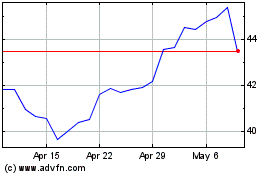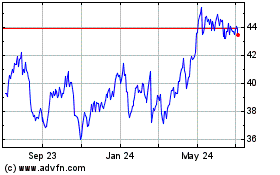China Bank Lending Rises on Home Buyer Borrowing
September 14 2016 - 9:20AM
Dow Jones News
BEIJING—Bank lending soared last month in China from a two-year
low in July, with a large share of the new credit going to people
buying new homes, according to central bank data.
The figures released Wednesday by the People's Bank of China
confirmed trends in the economy that economists say point to
weakness and could be troubling in the months ahead. Much of the
lending is going into a housing market that economists have said is
showing signs of overheating in some cities, and demand from
companies remains anemic.
Over all, Chinese financial institutions issued 948.7 billion
yuan ($142.19 billion) of new yuan loans in August, more than
double July's 463.6 billion and well above the level expected by
economists.
New lending to households reached 675.5 billion yuan last month,
a nearly 50% increase from July, according to the data. Of that
sum, medium- and long-term household loans, predominantly mortgage
lending, stood at 528.6 billion yuan, accounting for more than half
of the new loans issued in August. In July, almost all of the new
credit was mortgage lending.
Meanwhile, medium- and long-term loans to nonfinancial corporate
borrowers dropped 8 billion yuan last month, compared with an
increase of 151.4 billion yuan in July, the data showed.
Economists said the outsize mortgage lending and the weak
corporate demand continued a pattern of recent months and portrayed
an economy that, while growing, may not be doing so in a
sustainable way.
"The pattern in new credit over the past few months is
unchanged," said Ma Xiaoping, an economist with HSBC Bank. What
investment there is outside the property market is mainly being led
by the government, said Ms. Ma.
A series of indicators released earlier this month—from factory
output to retail sales—showed rebounding economic activity in
August largely sustained by government infrastructure spending and
property sales.
Ms. Ma and other economists said the latest central bank data
showed that credit remains widely available as the government tries
to prop up growth in an economy that has been gliding downward in
recent years.
"Today's data suggest that loose monetary conditions are still
supporting credit growth," said Julian Evans-Pritchard, an
economist of Capital Economics. He said the supply of credit was
likely to slow in the coming quarters as the central bank tries to
rein in financial risks.
Total social financing, a broad measure of credit in the economy
that includes nonbank financing, came to 1.47 trillion yuan in
August, three times July's level.
Corporate bonds increased to 330.6 billion yuan in August, over
50% more than the tally in July. Economists have said that a
sizable portion of that comes from special purpose companies backed
by local governments to fund infrastructure and other public
projects.
China's broadest measure of money supply, M2, was up 11.4% at
the end of August from a year earlier, higher than the 10.2% rise
at the end of July.
Another measure, M1, which covers liquid assets such as cash and
demand deposits, grew 25.3% year over year in August, compared with
a 25.4% pace posted a month earlier.
A surge in M1 in recent months has been interpreted by
economists as another sign that companies and individuals would
rather hoard cash than spend it as they wait out uncertain economic
times.
Liyan Qi
(END) Dow Jones Newswires
September 14, 2016 09:05 ET (13:05 GMT)
Copyright (c) 2016 Dow Jones & Company, Inc.
HSBC (NYSE:HSBC)
Historical Stock Chart
From Mar 2024 to Apr 2024

HSBC (NYSE:HSBC)
Historical Stock Chart
From Apr 2023 to Apr 2024
